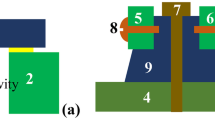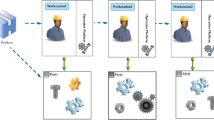Abstract
Selective disassembly is a systematic method to remove target components or high-valuable components from an EOL product for reuse, recycling and remanufacturing as quick and feasible as possible, which plays a key role for the effective application of circular economy. However, in practice, the process of selective disassembly is usually characterized by various unpredictable factors of EOL products. It is very difficult to identify a feasible disassembly sequence for getting the target components before taking actions due to the uncertainty. In this paper, a data-driven method of selective disassembly planning for EOL products under uncertainty is proposed, in which disassemblability is regarded as the degree of difficulty in removing components under uncertainty. Taxonomy of uncertainty metrics that represents uncertain characteristics of components and disassembly transitions of selective disassembly is established. Random and fuzzy assessment data of uncertainty is converted into qualitative values and aggregated to fit a prediction model based on the trapezium cloud model. The turning time of disassemblability is predicted for a given set of certainty degree. Further, the disassemblability values are applied to determine the best selective disassembly sequence in order to get target component with tradeoff between minimum number of disassembly operations and maximum feasibility. The effectiveness of the proposed method is illustrated by a numerical example. Moreover, by comparing to selective disassembly planning without considering uncertainty, the proposed method turns selective disassembly of EOL products more realistic than 11% and provide insights on how to design product to facilitate disassembly operations.











Similar content being viewed by others
References
Agrawal, S., & Tiwari, M. K. (2008). A collaborative ant colony algorithm to stochastic mixed-model U-shaped disassembly line balancing and sequencing problem. International Journal of Production Research, 46(6), 1405–1429.
Altekin, F. T. (2017). A comparison of piecewise linear programming formulations for stochastic disassembly line balancing. International Journal of Production Research, 55(24), 7412–7434.
Aydemir-Karadag, A., & Turkbey, O. (2013). Multi-objective optimization of stochastic disassembly line balancing with station paralleling. Computers & Industrial Engineering, 65(3), 413–425.
Behdad, S., & Thurston, D. (2012). Disassembly and reassembly sequence planning tradeoffs under uncertainty for product maintenance. Journal of Mechanical Design, 134(4), 041011.
Bentaha, M. L., Dolgui, A., Battaïa, O., Riggs, R. J., & Hu, J. (2018). Profit-oriented partial disassembly line design: Dealing with hazardous parts and task processing times uncertainty. International Journal of Production Research, 56(24), 7220–7242.
Bufardi, A., Gheorghe, R., Kiritsis, D., & Xirouchakis, P. (2004). Multicriteria decision-aid approach for product end-of-life alternative selection. International Journal of Production Research, 42(16), 3139–3157.
Fang, Y., Ming, H., Li, M., Liu, Q., & Pham, D. T. (2020). Multi-objective evolutionary simulated annealing optimisation for mixed-model multi-robotic disassembly line balancing with interval processing time. International Journal of Production Research, 58(3), 846–862.
Feng, Y., Gao, Y., Tian, G., Li, Z., Hu, H., & Zheng, H. (2018). Flexible process planning and end-of-life decision-making for product recovery optimization based on hybrid disassembly. IEEE Transactions on Automation Science and Engineering, 16(1), 311–326.
Fu, Y., Zhou, M., Guo, X., Qi, L., & Sedraoui, K. (2021). Multiverse optimization algorithm for stochastic biobjective disassembly sequence planning subject to operation failures. IEEE Transactions on Systems, Man, and Cybernetics: Systems. https://doi.org/10.1109/TSMC.2021.3049323
Gao, Y., Feng, Y., Wang, Q., Zheng, H., & Tan, J. (2018). A multi-objective decision making approach for dealing with uncertainty in EOL product recovery. Journal of Cleaner Production, 204, 712–725.
Guo, X., Zhou, M., Abusorrah, A., Alsokhiry, F., & Sedraoui, K. (2020). Disassembly sequence planning: A survey. IEEE/CAA Journal of Automatica Sinica, 8(7), 1308–1324.
Gupta, S. M., & McLean, C. R. (1996). Disassembly of products. Computers & Industrial Engineering, 31(1–2), 225–228.
Habibi, M. K. K., Battaïa, O., Cung, V. D., Dolgui, A., & Tiwari, M. K. (2019). Sample average approximation for multi-vehicle collection–disassembly problem under uncertainty. International Journal of Production Research, 57(8), 2409–2428.
Jeihoonian, M., Zanjani, M. K., & Gendreau, M. (2016). Accelerating Benders decomposition for closed-loop supply chain network design: Case of used durable products with different quality levels. European Journal of Operational Research, 251(3), 830–845.
Jeihoonian, M., Zanjani, M. K., & Gendreau, M. (2017). Closed-loop supply chain network design under uncertain quality status: Case of durable products. International Journal of Production Economics, 183, 470–486.
Kalayci, C. B., Hancilar, A., Gungor, A., & Gupta, S. M. (2015). Multi-objective fuzzy disassembly line balancing using a hybrid discrete artificial bee colony algorithm. Journal of Manufacturing Systems, 37, 672–682.
Kim, H. W., Park, C., & Lee, D. H. (2018). Selective disassembly sequencing with random operation times in parallel disassembly environment. International Journal of Production Research, 56(24), 7243–7257.
Kucukkoc, I., Buyukozkan, K., Satoglu, S. I., & Zhang, D. Z. (2019). A mathematical model and artificial bee colony algorithm for the lexicographic bottleneck mixed-model assembly line balancing problem. Journal of Intelligent Manufacturing, 30(8), 2913–2925.
Laili, Y., Li, Y., Fang, Y., Pham, D. T., & Zhang, L. (2020). Model review and algorithm comparison on multi-objective disassembly line balancing. Journal of Manufacturing Systems, 56, 484–500.
Li, J., Zhang, H. C., Gonzalez, M. A., & Yu, S. (2008). A multi-objective fuzzy graph approach for modular formulation considering end-of-life issues. International Journal of Production Research, 46(14), 4011–4033.
Li, K., Gao, Y., Zheng, H., & Tan, J. (2021). A data-driven methodology to improve tolerance allocation using product usage data. Journal of Mechanical Design, 143(7), 071101.
Liao, H., Deng, Q., Wang, Y., Guo, S., & Ren, Q. (2018). An environmental benefits and costs assessment model for remanufacturing process under quality uncertainty. Journal of Cleaner Production, 178, 45–58.
Lou, S., Feng, Y., Zheng, H., Gao, Y., & Tan, J. (2020a). Data-driven customer requirements discernment in the product lifecycle management via intuitionistic fuzzy sets and electroencephalogram. Journal of Intelligent Manufacturing, 31, 1721–1736.
Lou, S., Feng, Y., Li, Z., Zheng, H., Gao, Y., & Tan, J. (2020b). An edge-based distributed decision-making method for product design scheme evaluation. IEEE Transactions on Industrial Informatics, 17(2), 1375–1385.
Luo, Y., Peng, Q., & Gu, P. (2016). Integrated multi-layer representation and ant colony search for product selective disassembly planning. Computers in Industry, 75, 13–26.
Ma, J., Kremer, G. E. O., & Ray, C. D. (2018). A comprehensive end-of-life strategy decision making approach to handle uncertainty in the product design stage. Research in Engineering Design, 29(3), 469–487.
Matthieu, G., François, P., & Tchangani, A. (2012). Optimising end-of-life system dismantling strategy. International Journal of Production Research, 50(14), 3738–3754.
Ng, C. Y., & Chuah, K. B. (2013). Evaluation of design alternatives’ environmental performance using AHP and ER approaches. IEEE Systems Journal, 8(4), 1185–1192.
Nguyen, H. T., Dawal, S. Z. M., Nukman, Y., & Aoyama, H. (2014). A hybrid approach for fuzzy multi-attribute decision making in machine tool selection with consideration of the interactions of attributes. Expert Systems with Applications, 41(6), 3078–3090.
Ondemir, O., & Gupta, S. M. (2014). A multi-criteria decision making model for advanced repair-to-order and disassembly-to-order system. European Journal of Operational Research, 233(2), 408–419.
Özceylan, E., Kalayci, C. B., Güngör, A., & Gupta, S. M. (2019). Disassembly line balancing problem: A review of the state of the art and future directions. International Journal of Production Research, 57(15–16), 4805–4827.
Parsa, S., & Saadat, M. (2019). Intelligent selective disassembly planning based on disassemblability characteristics of product components. The International Journal of Advanced Manufacturing Technology, 104(5–8), 1769–1783.
Pistolesi, F., Lazzerini, B., Dalle Mura, M., & Dini, G. (2017). EMOGA: A hybrid genetic algorithm with extremal optimization core for multiobjective disassembly line balancing. IEEE Transactions on Industrial Informatics, 14(3), 1089–1098.
Radhi, M., & Zhang, G. (2016). Optimal configuration of remanufacturing supply network with return quality decision. International Journal of Production Research, 54(5), 1487–1502.
Ren, Y., Tian, G., Zhao, F., Yu, D., & Zhang, C. (2017). Selective cooperative disassembly planning based on multi-objective discrete artificial bee colony algorithm. Engineering Applications of Artificial Intelligence, 64, 415–431.
Saif, U., Guan, Z., Zhang, L., Zhang, F., Wang, B., & Mirza, J. (2019). Multi-objective artificial bee colony algorithm for order oriented simultaneous sequencing and balancing of multi-mixed model assembly line. Journal of Intelligent Manufacturing, 30(3), 1195–1220.
Sanchez, B., Rausch, C., Haas, C., & Saari, R. (2020). A selective disassembly multi-objective optimization approach for adaptive reuse of building components. Resources, Conservation and Recycling, 154, 104605.
Seidi, M., & Saghari, S. (2016). The balancing of disassembly line of automobile engine using genetic algorithm (GA) in fuzzy environment. Industrial Engineering and Management Systems, 15(4), 364–373.
Smith, S., & Hung, P. Y. (2015). A novel selective parallel disassembly planning method for green design. Journal of Engineering Design, 26(10–12), 283–301.
Tang, Y., Zhou, M., Zussman, E., & Caudill, R. (2002). Disassembly modeling, planning, and application. Journal of Manufacturing Systems, 21(3), 200.
Tian, G., Zhou, M., & Li, P. (2017). Disassembly sequence planning considering fuzzy component quality and varying operational cost. IEEE Transactions on Automation Science and Engineering, 15(2), 748–760.
Tripathi, M., Agrawal, S., Pandey, M. K., Shankar, R., & Tiwari, M. K. (2009). Real world disassembly modeling and sequencing problem: Optimization by Algorithm of Self-Guided Ants (ASGA). Robotics and Computer-Integrated Manufacturing, 25(3), 483–496.
Wang, J. Q., Wang, P., Wang, J., Zhang, H. Y., & Chen, X. H. (2015). Atanassov’s interval-valued intuitionistic linguistic multicriteria group decision-making method based on the trapezium cloud model. IEEE Transactions on Fuzzy Systems, 23(3), 542–554.
Wang, K., Li, X., & Gao, L. (2019a). Modeling and optimization of multi-objective partial disassembly line balancing problem considering hazard and profit. Journal of Cleaner Production, 211, 115–133.
Wang, K., Li, X., Gao, L., & Garg, A. (2019b). Partial disassembly line balancing for energy consumption and profit under uncertainty. Robotics and Computer-Integrated Manufacturing, 59, 235–251.
Yolmeh, A., & Salehi, N. (2015). An outer approximation method for an integration of supply chain network designing and assembly line balancing under uncertainty. Computers & Industrial Engineering, 83, 297–306.
Zhang, Z., Wang, K., Zhu, L., & Wang, Y. (2017). A Pareto improved artificial fish swarm algorithm for solving a multi-objective fuzzy disassembly line balancing problem. Expert Systems with Applications, 86, 165–176.
Zheng, F., He, J., Chu, F., & Liu, M. (2018). A new distribution-free model for disassembly line balancing problem with stochastic task processing times. International Journal of Production Research, 56(24), 7341–7353.
Zheng, H., Yang, S., Lou, S., Gao, Y., & Feng, Y. (2021). Knowledge-based integrated product design framework towards sustainable low-carbon manufacturing. Advanced Engineering Informatics, 48, 101258.
Zhou, L., Naim, M. M., & Disney, S. M. (2017). The impact of product returns and remanufacturing uncertainties on the dynamic performance of a multi-echelon closed-loop supply chain. International Journal of Production Economics, 183, 487–502.
Zhu, L., Zhang, Z., Wang, Y., & Cai, N. (2020). On the end-of-life state oriented multi-objective disassembly line balancing problem. Journal of Intelligent Manufacturing, 31, 1403–1428.
Acknowledgements
This work is supported by the National Natural Science Foundation of China (Nos. 51805472, 51975386), the Natural Science Foundation of Zhejiang Province (No. LZ21E050004) and China Postdoctoral Science Foundation (2021M690312).
Author information
Authors and Affiliations
Corresponding author
Additional information
Publisher's Note
Springer Nature remains neutral with regard to jurisdictional claims in published maps and institutional affiliations.
Appendices
Appendix 1
See Tables 1, 2, 3, 4, 5 and 6.
Appendix 2
See Table 7.
Appendix 3
Rights and permissions
About this article
Cite this article
Gao, Y., Lou, S., Zheng, H. et al. A data-driven method of selective disassembly planning at end-of-life under uncertainty. J Intell Manuf 34, 565–585 (2023). https://doi.org/10.1007/s10845-021-01812-0
Received:
Accepted:
Published:
Issue Date:
DOI: https://doi.org/10.1007/s10845-021-01812-0




